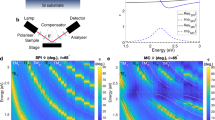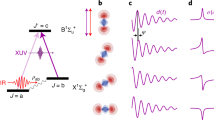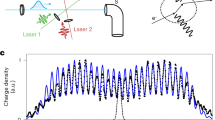Abstract
It is well known that a dielectric medium can be used to manipulate properties of light pulses. However, optical absorption limits the extent of possible control: this is especially important for weak light pulses. Absorption in an opaque medium can be eliminated via quantum mechanical interference, an effect known as electromagnetically induced transparency. Theoretical and experimental work has demonstrated that this phenomenon can be used to slow down light pulses dramatically, or even bring them to a complete halt. Interactions between photons in such an atomic medium can be many orders of magnitude stronger than in conventional optical materials.
This is a preview of subscription content, access via your institution
Access options
Subscribe to this journal
Receive 51 print issues and online access
$199.00 per year
only $3.90 per issue
Buy this article
- Purchase on Springer Link
- Instant access to full article PDF
Prices may be subject to local taxes which are calculated during checkout



Similar content being viewed by others
References
Boyd, R. W. Nonlinear Optics (Academic, Boston, 1992).
Scully, M. O. & Zubairy, M. S. Quantum Optics (Cambridge Univ. Press, Cambridge, 1997).
Arimondo, E. in Progress in Optics (ed. Wolf, E.) Vol. 35, 259–354 (North-Holland, Amsterdam, 1996).
Harris, S. E. Electromagnetically induced transparency. Phys. Today 50(7), 36–42 (1997).
Boller, K., Imamoglu, A. & Harris, S. E. Observation of an electromagnetically induced transparency. Phys. Rev. Lett. 66, 2593–2596 (1991).
Harris, S. E., Field, J. E. & Kasapi, A. Dispersive properties of electromagnetically induced transparency. Phys. Rev. A 46, R29–R32 (1992).
Fleischhauer, M. & Lukin, M. D. Dark-state polaritons in electromagnetically induced transparency. Phys. Rev. Lett. 84, 5094–5097 (2000).
Xiao, M., Li, Y., Jin, S. & Gea-Banacloche, J. Measurement of dispersive properties of electromagnetically induced transparency in rubidium atoms. Phys. Rev. Lett. 74, 666–669 (1995).
Kasapi, A., Jain, M., Yin, G. Y. & Harris, S. E. Electromagnetically induced transparency: Propagation dynamics. Phys. Rev. Lett. 74, 2447–2450 (1995).
Schmidt, O., Wynands, R., Hussein, Z. & Meschede, D. Steep dispersion and group velocity below c/3000 in coherent population trapping. Phys. Rev. A 53, R27–R30 (1996).
Lukin, M. D. et al. Spectroscopy in dense coherent media: line narrowing and interference effects. Phys. Rev. Lett. 79, 2959–2962 (1997).
Hau, L. V., Harris, S. E., Dutton, Z. & Behroozi, C. H. Light speed reduction to 17 metres per second in an ultracold atomic gas. Nature 397, 594–598 (1999).
Kash, M. M. et al. Ultra-slow group velocity and enhanced nonlinear optical effects in a coherently driven hot atomic gas. Phys. Rev. Lett. 82, 5229–5232 (1999).
Budker, D. et al. Nonlinear magneto-optics and reduced group velocity of light in atomic vapor with slow ground state relaxation. Phys. Rev. Lett. 83, 1767–1770 (1999).
Harris, S. E., Field, J. E. & Imamoğlu, A. Nonlinear optical processes using electromagnetically induced transparency. Phys. Rev. Lett. 64, 1107–1110 (1990).
Schmidt, H. & Imamoğlu, A. Giant Kerr nonlinearities obtained by electromagnetically induced transparency. Opt. Lett. 21, 1936–1938 (1996).
Hemmer, P. et al. Efficient low-intensity optical phase conjugation based on coherent population trapping in sodium. Opt. Lett. 20, 982–984 (1996).
Matsko, A. B. et al. Anomalous stimulated Brillouin scattering via ultraslow light. Phys. Rev. Lett. 86, 2006–2009 (2001).
Jain, M. et al. Efficient nonlinear frequency conversion with maximal atomic coherence. Phys. Rev. Lett. 77, 4326–4329 (1996).
Sokolov, A. V. et al. Raman generation by phased and antiphased molecular states. Phys. Rev. Lett. 85, 562–565 (2000).
Liang, J. Q. et al. Sideband generation using strongly driven Raman coherence in solid hydrogen. Phys. Rev. Lett. 85, 2474–2477 (2000).
Zibrov, A. S., Lukin, M. D. & Scully, M. O. Non-degenerate parametric self-oscillation via resonantly enhanced multiwave mixing in coherent media. Phys. Rev. Lett. 83, 4049–4052 (1999).
Harris, S. E. & Hau, L. V. Nonlinear optics at low light levels. Phys. Rev. Lett. 82, 4611–4614 (1999).
Lukin, M. D. & Imamoğlu, A. Nonlinear optics and quantum entanglement of ultra-slow single photons. Phys. Rev. Lett. 84, 1419–1422 (2000).
Bouwmeester, D., Ekert, A. & Zeilinger, A. The Physics of Quantum Information (Springer, Berlin, 2000).
Cirac, J. L., Zoller, P., Kimble, H. J. & Mabuchi, H. Quantum state transfer and entanglement distribution among distant nodes in a quantum network. Phys. Rev. Lett. 78, 3221–3224 (1997).
Lukin, M. D., Yelin, S. F. & Fleischhauer, M. Entanglement of atomic ensembles by trapping correlated photon states. Phys. Rev. Lett. 84, 4232–4235 (2000).
Oreg, J., Hioe, F. T. & Eberly, J. H. Adiabatic following in multilevel systems. Phys. Rev. A 29, 690–697 (1984).
Shvyd'ko, Yu. V. et al. Storage of nuclear energy through magnetic switching. Phys. Rev. Lett. 77, 3232–3235 (1996).
Kocharovskaya, O., Rostovtsev, Yu. & Scully, M. Stopping light via hot atoms. Phys. Rev. Lett. 86, 628–631 (2001).
Liu, C., Dutton, Z., Behroozi, C. H. & Hau, L. V. Observation of coherent optical information storage in an atomic medium using halted light pulses. Nature 409, 490–493 (2001).
Phillips, D., Fleischhauer, A., Mair, A., Walsworth, R. & Lukin, M. D. Storage of light in atomic vapor. Phys. Rev. Lett. 86, 783–786 (2001).
Mair, A. et al. Phase coherence and control of stored photonic information. Phys. Rev. Lett. (submitted).
Ham, B., Shahriar, M. S. & Hemmer, P. Enhanced nondegenerate four-wave mixing owing to electromagnetically induced transparency in a spectral hole-burning crystal. Opt. Lett. 22, 1138–1140 (1997).
Imamoğlu, A. Electromagnetically induced transparency with two dimensional electron spins. Opt. Comm. 179, 179–182 (2000).
Imamoğlu, A., Schmidt, H., Woods, G. & Deutsch, M. Strongly interacting photons in a nonlinear cavity. Phys. Rev. Lett. 79, 1467–1470 (1997).
Lukin, M. D., Matsko, A., Fleischhauer, M. & Scully, M. O. Quantum noise and correlations in resonantly enhanced wave mixing based on atomic coherence. Phys. Rev. Lett. 82, 1847–1850 (1999).
Vitali, D., Fortunato, M. & Tombesi, P. Complete quantum teleportation with a Kerr nonlinearity. Phys. Rev. Lett. 85, 445–448 (2000).
Lukin, M. D. et al. Dipole blockade and quantum information processing in mesoscopic atomic ensembles. Phys. Rev. Lett. 87, 037901 (2001).
Duan, L. M., Lukin, M. D., Cirac, J. I. & Zoller, P. Long-distance quantum communication with atomic ensembles and linear optics. Preprint quant-ph/0105105 at 〈http://xxx.lanl.gov〉 (2001); Nature (submitted).
Acknowledgements
We would like to thank S. Harris and M. Scully for many discussions. We also thank J. I. Cirac, L.-M. Duan, M. Fleischauer, D. Phillips, H. Schmidt, R. Walsworth, S. Yelin and P. Zoller. This work was supported by the NSF via a grant to ITAMP and through an ITR program (M.L.) and by a David and Lucile Packard Fellowship (A.I.).
Author information
Authors and Affiliations
Corresponding author
Rights and permissions
About this article
Cite this article
Lukin, M., Imamoğlu, A. Controlling photons using electromagnetically induced transparency. Nature 413, 273–276 (2001). https://doi.org/10.1038/35095000
Issue Date:
DOI: https://doi.org/10.1038/35095000
This article is cited by
-
Linear and phase controllable terahertz frequency conversion via ultrafast breaking the bond of a meta-molecule
Nature Communications (2024)
-
Non-Hermitian control between absorption and transparency in perfect zero-reflection magnonics
Nature Communications (2023)
-
Topological nonlinear optics with spin-orbit coupled Bose-Einstein condensate in cavity
npj Quantum Information (2022)
-
Electromagnetically induced moiré optical lattices in a coherent atomic gas
Frontiers of Physics (2022)
-
Twist-angle engineering of excitonic quantum interference and optical nonlinearities in stacked 2D semiconductors
Nature Communications (2021)
Comments
By submitting a comment you agree to abide by our Terms and Community Guidelines. If you find something abusive or that does not comply with our terms or guidelines please flag it as inappropriate.



